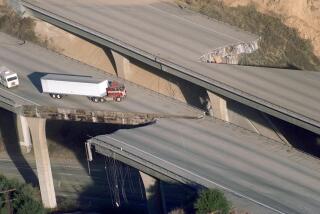Nuclear Test Monitor Finds Going Smooth in Soviet Union
LA JOLLA â The installation of monitoring devices in the Soviet Union during the past month to detect underground nuclear tests has proceeded more smoothly than originally expected, the first American scientist to return from the project said Tuesday.
UC San Diego seismologist Jonathan Berger said that portable equipment already in place near a Soviet underground testing site 1,800 miles southeast of Moscow has recorded several earthquakes and a July 17 American nuclear test in Nevada. The data eventually will allow Americans to understand more precisely the nature of shock waves transmitted through the areaâs geology. This in turn will permit accurate monitoring of any Soviet violations under future test-ban treaties.
âWeâre very pleased at the amount of data that we have gotten so far, even though there is no (Soviet nuclear) testing going on so far,â Berger said in an interview. The Soviets are observing a unilateral ban on underground testing until at least Aug. 6, the 41st anniversary of the first nuclear bombing, at Hiroshima, Japan.
The work by Berger and other UCSD scientists from the Institute of Geophysics and Planetary Physics at the Scripps Institution of Oceanography is the result of an unusual agreement signed in May. The agreement between the Natural Resources Defense Council, a private environmental group based in New York, and the Soviet Academy of Sciences, which is directed by the Soviet government, calls both for American-manned monitoring stations in the Soviet Union and for similar stations near the Nevada test site, to be staffed by Soviet scientists.
The private council wants to show that accurate monitoring of underground nuclear testing can be accomplished with present technical knowledge and that the fear that violations would go undetected should not be an impediment to a treaty banning such tests. The Soviets have been pressuring the United States to join in immediate negotiations for a permanent test ban, which the American government has resisted until recently. The U.S. government remains skeptical of the ability to detect violations and also argues that some underground testing is necessary to maintain and modernize the American nuclear arsenal.
Berger, a worldwide expert in seismological instrumentation, had expressed some apprehensions in May over the political implications of the project when he was picked by the resources defense council to travel to the Soviet Union.
But on Tuesday, he said that politics has not intruded upon the work of the scientists so far, and that he was now less worried than previously.
âWeâve been dealing strictly with (Soviet) scientific people that are less involved in their politics than we are in ours,â Berger said. âWe spoke with them (informally) in generalities about hopes that all of this will help lead to test ban treaties, to peace; in essence, that, gee, weâre all nice people.â Berger said that the scientists were well-covered by Soviet and Western media, and had received a message of congratulations from Soviet leader Mikhail S. Gorbachev.
Berger said that construction is under way to place permanent equipment underground at the first of three planned monitoring sites, arranged in a triangular pattern around the main Soviet underground testing facility of Semipalatinsk. Plans call for a yearlong presence by UCSD researchers to analyze the data, which will allow detailed seismic maps to be obtained from the region.
âThe rocks around the (Soviet) site are of a different type than in the (Western United States) and transmit waves differently,â Berger said. âAnd knowing how to measure activity accurately through them is a key factor in scenarios you might envision for monitoring full-scale any (Soviet tests) that might follow a test-ban treaty.â
Berger said that the recording of the July 17 U.S. underground explosion in Nevada allowed Americans for the first time to measure U.S. tests as the Soviets would measure them. That information will allow Americans to calibrate more accurately the equipment used in this country to measure Soviet tests.
Berger said that UCSD scientists will help install similar equipment in California or Nevada for the Soviet scientific group, which he said plans to arrive in the United States sometime this autumn.
More to Read
Sign up for Essential California
The most important California stories and recommendations in your inbox every morning.
You may occasionally receive promotional content from the Los Angeles Times.










